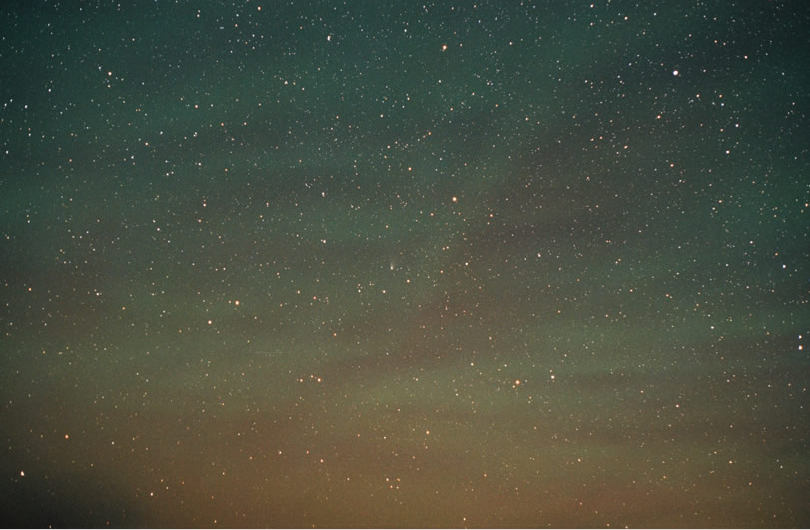Banded Airglow
Banded Airglow: Unveiling the Mesosphere-Lower Thermosphere Region
Have you ever gazed up at the night sky and noticed a mesmerizing display of banded and patchy structures? This captivating phenomenon is known as banded airglow. While it may appear as a static display, these bands actually change imperceptibly over minutes or tens of minutes. What causes this enchanting dance of light in the sky?
Banded airglow arises from the modulation of tenuous gas density and temperature by slowly moving gravity waves at a height of 90-100 km in the atmosphere. These gravity waves are responsible for the mesmerizing patterns that captivate our eyes and spark our curiosity. By studying the intensity and spectra of airglow, scientists gain valuable insights into the mesosphere-lower thermosphere region.
One remarkable image that beautifully captures the banded airglow was taken by Doug Zubenel in Cherry County, Nebraska. This image showcases the intricate structure of the airglow, with its ever-changing bands and patches. The field measures 41°X27°, and the photograph was captured using a 50mm lens at f/2.8. The exposure time was an impressive 15 minutes, allowing for a stunning portrayal of this atmospheric phenomenon.
It's important to note that airglow can be observed in various locations around the world, each offering its unique spectacle. The Nebraska sky, in this case, presented an ideal canvas for showcasing the banded airglow. The image itself is a testament to the wonders that await us when we cast our gaze upward.
While banded airglow may appear ethereal and intangible, it serves as a window into the mesosphere-lower thermosphere region. By analyzing the intensity and spectra of airglow emissions, scientists can extract valuable information about the composition and dynamics of this atmospheric layer.
The mesmerizing patterns of banded airglow are a result of the interplay between gravity waves and the tenuous gas density and temperature. Gravity waves, in this context, are not the same as the waves we typically associate with water. Instead, they are oscillations that propagate through a fluid medium, such as the atmosphere. These waves arise from various sources, including atmospheric disturbances caused by weather systems, mountains, and even thunderstorms.
The slow movement of these gravity waves gives rise to the gradual modulation of gas density and temperature, leading to the formation of banded structures in the airglow. These bands may appear as distinct regions of varying intensity or as patches of light scattered across the sky. The ever-changing nature of banded airglow adds to its allure, as it constantly evolves and surprises us with new patterns.
Studying banded airglow not only unveils the mesmerizing beauty of our atmosphere but also provides valuable scientific insights. By analyzing the intensity and spectra of airglow emissions, scientists can determine the concentration of specific atmospheric constituents, such as oxygen and nitrogen. These measurements help us understand the chemical processes occurring in the mesosphere-lower thermosphere region and shed light on the complex interactions between atmospheric components.
In conclusion, banded airglow is a captivating atmospheric phenomenon that showcases the intricate dance of gravity waves and gas density fluctuations in the mesosphere-lower thermosphere region. Through careful analysis of airglow intensity and spectra, scientists gain valuable insights into the composition and dynamics of this atmospheric layer. The ever-changing patterns of banded airglow continue to inspire and fascinate us, reminding us of the hidden wonders that await us when we cast our eyes to the sky.

Banded Airglow. This image by Doug Zubenel taken in Nebraska nicely shows the airglow's sometimes banded and patchy structure. They change imperceptably over minutes or tens of minutes and arise as slowly moving gravity waves at the airglow's height of 90-100 km modulate the tenuous gas density and temperature. Measurements of airglow intensity and spectra give insight on the mesosphere - lower thermosphere region.
Imaged in Cherry County, Nebraska, 2300 CDT July 23,2000. The field measures 41°X27°. 50mm lens at f/2.8, 15 minute guided exposure on Fuji NHG II 800.
Image ©Doug Zubenel, shown with permission.
Note: this article has been automatically converted from the old site and may not appear as intended. You can find the original article here.
Reference Atmospheric Optics
If you use any of the definitions, information, or data presented on Atmospheric Optics, please copy the link or reference below to properly credit us as the reference source. Thank you!
-
<a href="https://atoptics.co.uk/blog/banded-airglow/">Banded Airglow</a>
-
"Banded Airglow". Atmospheric Optics. Accessed on November 22, 2024. https://atoptics.co.uk/blog/banded-airglow/.
-
"Banded Airglow". Atmospheric Optics, https://atoptics.co.uk/blog/banded-airglow/. Accessed 22 November, 2024
-
Banded Airglow. Atmospheric Optics. Retrieved from https://atoptics.co.uk/blog/banded-airglow/.